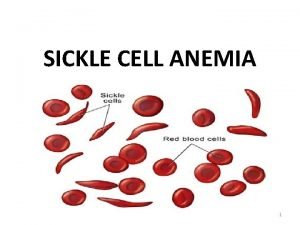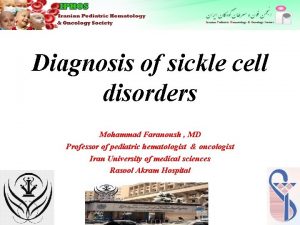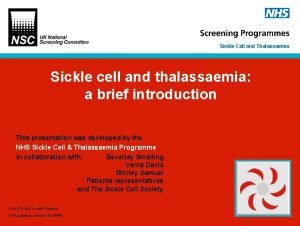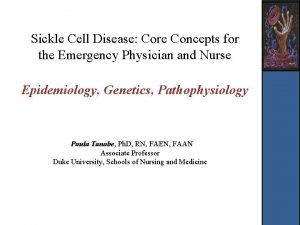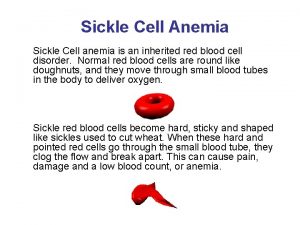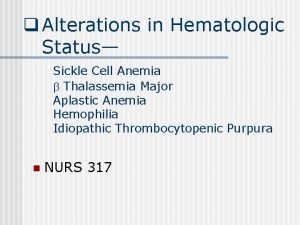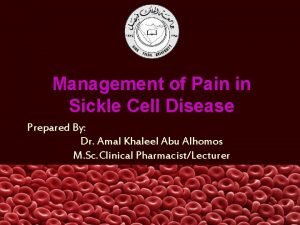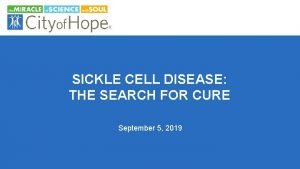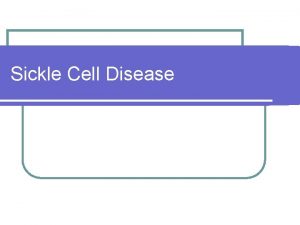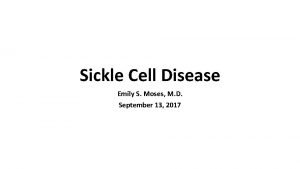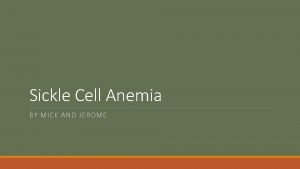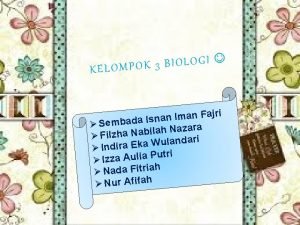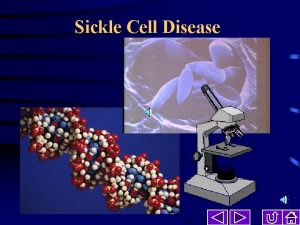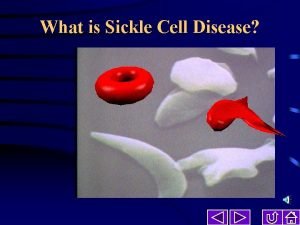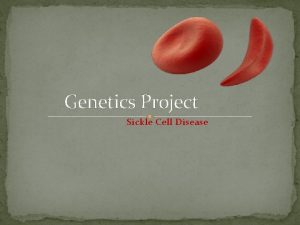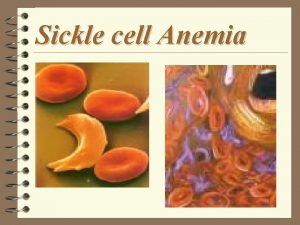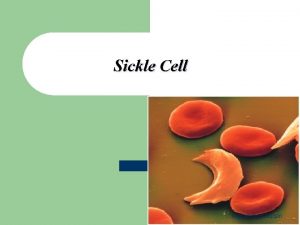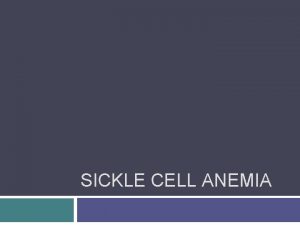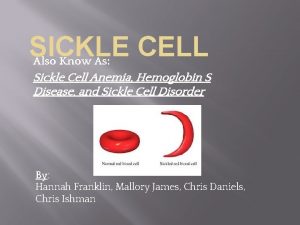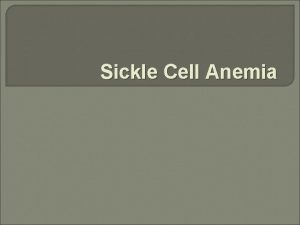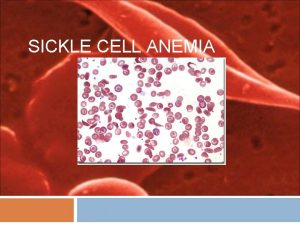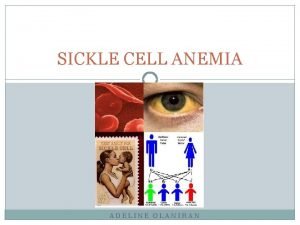Sickle Cell Disease and Depression To determine the



































- Slides: 35

Sickle Cell Disease and Depression To determine the incidence of depression and anxiety symptoms in an outpatient population of Sickle Cell Disease patients (SCD) by utilizing the Patient Health Questionnaire (PHQ-9) and Generalized Anxiety Disorder (GAD-7) to improve clinical practice. LAURA QUAYE Scholarly Project Presentation Maryville University 12/08/17

Oversight Members • Assistant Dean of Nursing: – Dr. Elizabeth Buck, Ph. D, RN • Committee Chair – Dr. Phares Ph. D, DNP, APRN-BC • Committee Members – Dr. Haung (Pediatrician, Hematologist) – Dr. Durairaj (Family Practice)

Abstract Purpose/Aim: To determine the incidence of depression and anxiety symptoms in an outpatient population of (SCD) by using the Patient Health Questionnaire (PHQ-9) and Generalized Anxiety Disorder (GAD 7) to improve clinical practice. Background: SCD patients have an increased risk of developing behavioral problems (Bakri et al. , 2014). Pain resulting from Sickle Cell Disease (SCD) has been associated with depression (Anie et al. , 2010). Methods: Quantitative observational cross‐sectional study was used to sample 30 SCD patients. Descriptive analysis using Fisher Exact Test.

Abstract Outcomes/Results: The reliability was supported with a high cronbach’s alpha. The results showed that almost all the participants reported two or more symptoms of anxiety or depression. Conclusion: Screening for depression and anxiety utilizing the PHQ-9/GAD-7 will be the first step in providing effective interventions for SCD patients with depression and anxiety symptoms.

Background/Significance • The sickled red blood cells cause obstruction of blood flow in the small blood vessels causing severe pain, which eventually result in infections, organ damage, and stroke (Ferri, 2012). • CDC estimated that one out thirteen African-American babies is born with sickle cell trait the United States (CDC, 2017). • Sickle Cell Disease (SCD) is a commonly inherited disease among African Americans. • Average lifespan of individuals with SCD is from 22 to 50 years. • Between the years 2004 -2008 there were approximately 5, 100 people with SCD in California; 25% were within the ages of 6 - 17 out of which 85% were African American (CDC, 2017).

Literature Review • SCD patients have an increased risk of developing behavioral problems (Bakri, Ismail, Elsedfy, Amr & Ibrahim, 2014). • Pain resulting from Sickle Cell Disease (SCD) has been associated with depression (Anie et al. , 2010). • Depression in SCD mostly goes untreated due to the stigma and rates of disability associated with this population (Jenerette, Funk, & Murdaugh 2005).

Literature Review • Levenson, et al. , (2008) associated depression and anxiety with pain in SCD patients and suggested clinicians recognize and treat anxiety and depression in SCD patients. • Another study reported that 10% to 30% of adolescents with chronic illnesses have at least one anxiety or depression symptom and a higher risk of developing anxiety disorders compared to adolescents without SCD (Amr, Amin, & Hablas, 2010). • Research has suggested that many clinicians tend to miss the psychological effect of SCD.

Literature Review Strengths Weakness • Treatment improves patient outcomes. • Unmet need contributes unnecessary fears and emotions leading to increased illness (Acton & • Early detection of depressive and anxiety disorders can be enhanced by implementing routine screening (Bermejo, Niebling, Berger, & Harter, 2005). Malathum, 2000).

Literature Review Gaps • Identifying needs of SCD patients. • How effective are the depression and anxiety screening tools used in outpatient clinic for SCD patients? • Analyze the relationship between anxiety and depression in SCD patients.

PICO & Research Questions PICO Research Questions P: The 18 to 45 year-old patients at outpatient clinic with SCD RQ 1: In 18 -45 year-old outpatient clinic patients having Sickle Cell Disease, does the implementation of the PHQ-9 increase the identification of depression? I: Implementation of the(PHQ 9/GAD 7) C: Comparing SCD patients with depression and SCD patients with anxiety. O: increased identification of anxiety/depression outcome. 10 RQ 2: In 18 -45 year-old outpatient clinic patients having Sickle Cell Disease, does the implementation of the GAD-7 increase the identification of Anxiety? Null hypothesis: PHQ-9 and GAD 7 screening does not identify symptoms of anxiety and depression.

Purpose and Research Aims Purpose Research Aims • The purpose of this project is to determine the incidence of depression and anxiety in an outpatient population of SCD patients using PHQ-9 and GAD-7 as screening tools to improve clinical practice. • Identify a population of patients with SCD, with no history and treatment of depression. • Utilize the Patient Health Questionnaire (PHQ-9) and Generalized Anxiety Disorder (GAD-7) to establish a depression and anxiety score.

Maslow’s Conceptual Framework Best, D. , Day, E. , Mc. Carthy, T. , Darlington, I. , & Pinchbeck, K. (2008).

Assumptions of the Study • Maslow’s framework comprises • In SCD patients, their physiological needs comprise of the biological, physical, their daily activities of pain social, and environmental management, and reliance on needs of an individual. pain medication. • Maslow described his assumptions in a form of pyramid of hierarchy with the basic needs at the bottom and the higher needs at the base. • Maslow argued that unmet needs contribute to increasing anxiety and tensions that might lead to increased illness (Acton & Malathum, 2000). • Safety needs include a safe environment to live, education, and employment opportunities. • Love and relationship needs are the ability to make friends and have supportive family to overcome the stigma of the illness. • Good health as fulfillment of all the hierarchy of needs.

Methodology • Quantitative observational cross‐sectional study where 30 participants were randomly recruited from Metropolitan Clinic in San Bernardino County, CA. • IRB approval from Maryville University was granted before data collection. • Participants signs informed consent before taking the surveys. • No permission is required to reproduce, translate, display, or distribute the PHQ-9 and GAD-7 screening tools. • Settings is private and controlled.

Data Collection Plan • Sample size: 30 • Instruments: Demographic data, PHQ 9 and GAD-7 questionnaires. • Team: Primary care practice, medical assistants, providers • Descriptive Analysis: Fisher Exact test • Study Duration: 2 months • Collection setting: Outpatient primary clinic.

Participants • Inclusion criteria – History of Sickle Cell Disease, between the ages of 18 and 45 years old, with no history of Depression. • Exclusion criteria – Under 18 years of age and over the age of 45 years, with diagnosis of depression. • There is no money or gifts to participants for participation in this study. • Budget financial needs include paper and supplies for the project and collecting data.

Demographic Data

Screening Tools

Data Analysis • Microsoft Excel and the data was run statistically on IBM SPSS Statistics. • Fisher’s Exact Test was used for this study because of the small sample size. • According to Cochran if 80% of expected values are greater than 5 and all expected values are greater than 1, then chi-square analysis will be the appropriate test to use. • Descriptive statistical data are presented by mean values and standard deviations.

Demographic Characteristics & Severity Ratings of Survey

Analysis GAD-7

Analysis PHQ-9

Results • The reliability was supported with a high Cronbach’s alpha interval ranging from PHQ 9: 0. 873 and GAD-7: 0. 629. • There was a significant difference because more than 90% of SCD participants presented with mild or moderate depression or anxiety. • 46% of the total population showed mild anxiety while 53. 3% exhibited moderate anxiety. • For those with Depression, 6. 67% showed mild depression, 50. 0% recorded minimum depression and, 43. 3% had moderate depression. • The results showed that almost all the participants reported two or more symptoms of anxiety or depression.

Results cont’d Thirty SCD patients were sampled and evaluated as to whether the number of SCD with depression (f =15 ) equaled to number of patients with anxiety (f =16), p ≤ 0. 05, which means more than half of the SCD patients also have anxiety.

Project impact & Practice change Project Impact • The main impact is educating providers on SCD and importance of using PHQ-9/GAD-7 and to increase provider’s knowledge. Practice Change • PHQ-9 and GAD-7 assessment tool has been added to the standard of care for all SCD patients. • All patients are being screened with PHQ-9 screeners on annual visits to determine their psychological needs. • Moderate to severe depression/anxiety are referred to psychiatrist and collaborate to provide coordination of care including follow up and a plan to monitor these patients

Strength and Limitation Strengths • The instruments used assured credibility and the data collection plans made it easy for further analysis. • The establishment of a diverse population for the study. Limitations • Small sample size which means the results cannot be generalized. • Short length of study.

Implications for Nursing Practice • Screening for anxiety and depressive disorders prevents SCD population from the risk of extreme anxiety or depression. • Early assessment by clinicians will enable referral to appropriate services at the right time. • To ensure that their predisposing factor does not develop into anxiety or depression. • The implementation of screening SCD patients will be beneficial to understand the psychological burdens of SCD patients. • Involvement of multi-disciplinary treatment teams including a psychologist, counselors, families, and social support to reduce recurrence of symptoms.

Implications for Future Study • Future studies should explore how anxiety and depression affects sickle crisis or pain and daily adherence behaviors. • Another study should also review how nurse’s education influences patients with SCD and their interventions to reduce hospitalization and its benefits to patients and families. • More studies are needed to determine the best interventions developed by nurses to address psychological needs of families and adolescents affected with SCD.

Conclusion • Implementation of PHQ and GAD will help to identify depression among this population in outpatient clinics. • The implementation of Maslow concept of self- actualization id beneficial to understand the psychological burdens of SCD patients and also to identify their needs to improve their quality of life. • Include PHQ-9 and GAD-7 assessment to the standard care for patient with SCD. • Close follow-up and collaboration with different disciplines. • Recognition and provision of psychosocial support helps patients and families.

References Acton, G. , & Malathum, P. (2000). Basic need status and healthpromoting self-care behavior in adults. Western Journal Of Nursing Research, 22(7), 796 -811. Amr, M. , Amin, T. , & Hablas, H. (2010). Psychiatric disorders in a sample of Saudi Arabian adolescents with Sickle cell disease. Child & Youth Care Forum, 39(3), 151 -166. doi: 10. 1007/s 10566 -009 -9091 -9. Retrieved from http: //web. b. ebscohost. com/ehost/pdfviewer? sid=9 5 e 38767 -4684 -4 d 13 -a 1173 dad 19 c 30 e 06%40 sessionmgr 112&vid=11&hid=118. Anie, A. K. , Egunjobi, E. F. , & Olu O Akinyanju, O. O. , (2010). Psychosocial impact of sickle cell disorder: Perspectives from a Nigerian setting. Globalization and Health, 6(2), 6 -22 Retrieved from http: //www. globalizationandhealth. com/content/6/1/2

References Bakri, M. H, Ismail, E. A. , Elsedfy, G. O. , Amr, M. A. , & Ibrahim, A. (2014). Behavioral impact of sickle cell disease in young children with repeated hospitalization. Saudi J Anaesth. 2014; 8: 504 -9 from: http: //www. saudija. org/text. asp? 2014/8/4/504/140867 Bermejo, I. , Niebling, W. , Berger, M. , & Härter, M. (2005). Patients' and physicians' evaluation of the PHQ-D for depression screening. Primary Care & Community Psychiatry, 10(4), 125 -131. Best, D. , Day, E. , Mc. Carthy, T. , Darlington, I. , & Pinchbeck, K. (2008). The hierarchy of needs and care planning in addiction services: What Maslow can tell us about addressing competing priorities? . Addiction Research & Theory, 16(4), 305 -307.

References Carpenter, M. Y. , Elkin, T. D. , & Starnes, S. E. (2009). Behavioral inhibition and its relation to anxiety and depression symptoms in adolescents with sickle cell disease: A preliminary study. Journal of Pediatric Oncology Nursing, 26(3), 156 -163. Centers for Disease Control and Prevention (2017). Sickle cell disease. Retrieved from http: //www. cdc. gov/ncbddd/sicklecell/documents/sicklecelltrait factsheet_english. pdf Center for Disease Control and Prevention, (2017). Sickle cell disease. Retrieved from https: //www. cdc. gov/ncbddd/sicklecell/data. html Erskine, R. (2012). Adolescent boys with sickle cell disease: A qualitative study. Clinical Child Psychology & Psychiatry, 17(1), 17 -31. doi: 10. 1177/1359104511399843.

References Ferri, E. (2012). Ferri ‘s clinical advisor. Elsevier Mosby Inc. Philadelphia, PA. Jenerette, C. (2008). Relationships among types of social support and QOL in adults with sickle cell disease. Southern Online Journal Of Nursing Research, 8(3). Levenson, J. , Mc. Clish, D. , Dahman, B. , Bovbjerg, V. , de A Citero, V. , Penberthy, L. , &. . . Smith, W. (2008). Depression and anxiety in adults with sickle cell disease: the Pi. SCES project. Psychosomatic Medicine, 70(2), 192 -196. Tanabe, P. , Thornton, V. L. , Martinovich, Z. , Todd, K. H. , Wun, T. , & Lyons, J. S. (2013). The Emergency Department Sickle Cell Assessment of Needs and Strengths (ED-SCANS): Reliability and validity. Advanced Emergency Nursing Journal, 35(2), 143 -153. doi: 10. 1097/TME. 0 b 013 e 31828 ecbd 5

References Wang, W. , Bian, Q. , Zhao, Y. , Li, X. , Wang, W. , Du, J. , &. . . Zhao, M. (2014). Reliability and validity of the Chinese version of the Patient Health Questionnaire (PHQ-9) in the general population. General Hospital Psychiatry, 36(5), 539 -544. doi: 10. 1016/j. genhosppsych. 2014. 05. 02

QUESTIONS? THANK YOU!
 Gene therapy for sickle cell disease
Gene therapy for sickle cell disease Incomplete dominance allele
Incomplete dominance allele Types of sickle cell disease
Types of sickle cell disease Sickle cell anemia
Sickle cell anemia Types of sickle cell disease
Types of sickle cell disease Multiple alleles example blood type
Multiple alleles example blood type Difference between sickle cell anaemia and thalassemia
Difference between sickle cell anaemia and thalassemia Sickle cell karyotype
Sickle cell karyotype Life expectancy of sickle cell patients
Life expectancy of sickle cell patients Sickle cell hemoglobin structure
Sickle cell hemoglobin structure Sickle cell anemia lab values
Sickle cell anemia lab values Does tiki barber have sickle cell
Does tiki barber have sickle cell 4 steps of protein synthesis
4 steps of protein synthesis Pethidine in sickle cell
Pethidine in sickle cell Sickle cell karyotype
Sickle cell karyotype Pedigree of sickle cell anemia
Pedigree of sickle cell anemia Sickle cell hemoglobin structure
Sickle cell hemoglobin structure Sickle cell punnett square
Sickle cell punnett square Is sickle cell anemia codominant
Is sickle cell anemia codominant Sickle cell osteomyelitis
Sickle cell osteomyelitis Blood
Blood Sickle blood cell
Sickle blood cell Sickle cell anemia
Sickle cell anemia Codominance in sickle cell anemia
Codominance in sickle cell anemia Sickle cell anemia
Sickle cell anemia Nata sickle cell
Nata sickle cell Sickle cell anemia
Sickle cell anemia Sickle cell pain
Sickle cell pain Sickle cell anemia symptoms
Sickle cell anemia symptoms Sickle cell anemia mutation
Sickle cell anemia mutation Everardo cobos
Everardo cobos Inheritance pattern of sickle cell anemia
Inheritance pattern of sickle cell anemia Sickle cell anemia dna sequence
Sickle cell anemia dna sequence Persilangan sickle cell anemia
Persilangan sickle cell anemia Pbs sickle cell
Pbs sickle cell Communicable disease and non communicable disease
Communicable disease and non communicable disease



